Review for Utawarerumono: Volume 2 - In the Face of Evil
Introduction
The second volume of the unpronounceable anime cues itself up for review in my DVD player, and I must admit that I'm a little bit tantalised by the prospect. After all the first volume turned out to be quite the pleasant surprise, a fantasy adventure that appeals to a broad audience, but doesn't dilute its efforts by doing so. It was part comedy, part drama, part war epic, part mystery, part period tale, and part gentle character examination. It had its clichés and it had its originality, and it had cute little dog-eared girls as well. So often a promising start is let down by what follows, but I'm keeping my fingers crossed for Utawarerumono, not least because I bought the whole series in one go. I'm reviewing the Region 1 release, but you should be aware that it has been released in the UK as well.
Utawarerumono is a fantasy series set in a strange world. It's based on a PC game, but before you recoil in horror, it's one of those narrative adventure PC games that the Japanese are so fond of, barely interactive animated storybooks, with sex scenes. This anime ditches the sex to produce something a little more appropriate for a broader audience. This is a strange world, populated with dog-eared people, strange animals, very real deities, oppressive governments, and on the verge of war. It's in this world that a masked stranger awakes. Hakuoro has no memory of his past, but a mask is affixed to his face, impossible to remove. He wakes in the village of Yamayura, healed and nursed back to health by a young girl named Eluluu, and is taken to heart by the kindly village people. Against all the adversities and challenges this harsh world throws against the people of Yamayura, this noble, enigmatic man becomes a beacon of hope, and a source of strength. But this is just the first step for Hakuoro to take towards his destiny of changing the world.
The next five episodes are presented on this disc from ADV
6. Gathering Force
The Emperor Inkalla and his nephew Nuwangi are busy throwing their weight around, terrorising even innocent villages in the hope of putting Hakuoro's rebellion down. Of course this has the opposite effect, and when former Samurai General Benawi makes the mistake of mentioning it to the Emperor, he's censured and assigned to guard duty in the hinterlands. Unbeknownst to him, the Tadokori checkpoint is the next logical target for Hakuoro. But first Hakuoro has to deal with an itinerant merchant who has wandered into the wrong part of town.
7. Invasion of the Imperial City
With Benawi imprisoned, Nuwangi's excesses are just getting worse, while Inkalla is blind to what is actually happening in his country. It's time for Hakuoro to end this war, and he leads the allied villagers to the Imperial City. At the end, Inkalla realises his predicament, and he calls on Benawi to protect him, and when Hakuoro and his allies reach the palace, it looks as if he faces a fight he can only win at horrific cost. He certainly isn't expecting Benawi to end the war.
8. The Mediator
Teoro and the other villagers return to Yamayura, even as Hakuoro is crowned emperor of the newly formed state of Tuskuru. Eluluu and Aruruu choose to stay with him, and Oboro joins Benawi as a general of the army. It isn't long before affairs of state make their presence felt. Fortunately the arrival of the Onkamiyamukai is a pleasant occurrence. They are mediators, winged people who strive for peace between nations, and the diplomats Princess Urutori and Munto are visiting Tuskuru to see if the land has changed for the better or the worse since the regime change. But even as friendships are being forged, it becomes clear that Princess Urutori has something, or rather someone to hide.
9. Taboo
Hakuoro's first real test as emperor comes when a delegation from the neighbouring land of Shikeripechim arrives in full military bluster. Emperor Niwe has decided that the upstart new nation is ripe for the picking, and demands that Hakuoro submits to annexation immediately. While Oboro is ready to draw his sword, Hakuoro is unexpectedly diplomatic and agreeable. His reasons become clear when Benawi confirms that Niwe's forces seriously outnumber theirs, and Hakuoro is busy making plans for the defence of Tuskuru. His only chance is to break one of society's most stringent unwritten rules, and to even contemplate doing so distances him from Eluluu.
10. The Mercenary
A ship wrecked in a storm, a beach full of corpses, and one survivor, covered in their blood. The smart thing to do, you would think, is to put said survivor in prison, just in case, and that is what Kurou and Oboro do. But appearances can be deceptive. The ship was a slave galley from Na Tuunk, and Karula was one of the gladiators being transported. She may be phenomenally strong, and lethal to her foes, but showing restraint to the people of Tuskuru (she only knocks out the guards when escaping from prison), changes the mind of Hakuoro. With the threat of Shikeripechim never too far away, it doesn't hurt to have friends like Karula. Meanwhile the official delegation of mediators is assigned to Tuskuru, and these Onkamiyamukai are familiar faces.
Picture
This being a Region 1 disc, Utawarerumono gets a 1.78:1 anamorphic transfer of the NTSC variety. It means a slightly lower resolution than PAL discs, and a greater prevalence of aliasing, but it also means that the image is clear, sharp, and colourful, and the animation is smooth, and free of ghosting and judder. Utawarerumono is an interesting animation, period fantasy as it is, it reminds me somewhat of Inuyasha, with its simplicity of character designs, and wholesome bright, primary colours. That said, there is something of a more atmospheric aesthetic to the animation, it's much more detailed and vivid, and with the fantasy setting, there's something Ghibli-esque about it, reminiscent of films like Nausicaa and Princess Mononoke. All in all, it's a very pleasant show to watch. That's with the exception of crowd and battle sequences. Where there are a lot of people on screen at any one time, and shown at a distance, the animators have used something akin to a 3D RTS graphics engine to render the crowds in CGI, and the graphics do tend to stick out like a sore thumb. Also when the camera gets a little too close, the uniformity of features becomes apparent.
Sound
Utawarerumono comes in DD 5.1 English and DD 2.0 Japanese stereo, along with optional translated subtitles, and a signs only track. In a nice move, the episode titles get a subtitle translation, but in an unconventional font that very much suits the look of the show. The dialogue is clear in both versions, and the show gets some very earthy, folk style music, along with a couple of very pleasant theme songs. I was happy enough with the Japanese version, which had some memorable character voices. Not so much for the English dub, which is pretty run of the mill for anime, not exactly standing out, but not really all that awful either.
Extras
Volume 2 of Utawarerumono came with an optional art box in the US, all you had to do was pay a little extra and you would get a sturdy card construction to store all six discs in, decorated with colourful imagery from the show.
Utawarerumono gets the usual jacket picture and animated menu, and this being a Region 1 disc, it also autoplays with ads for Anime Network and the now dead Newtype USA magazine.
Inside the very shiny green Amaray style case, you can read an eight-page booklet, which offers interviews with the Art Director Kenji Kato, Chief CGI Designer Osamu Karasawa, voice actors Daisuke Namikawa (Benawi), and Tsuyoshi Koyama (Kurou), and English ADR Director Christine Auten.
On the disc you can find a seven-page glossary, explaining the terms used in the show, and detailing some of the characters that you'll encounter.
The Q & A lasts 16 minutes, and Hakuoro and Eluluu answer viewer questions about the show over appropriate clips from the episodes.
The Extended Episode Previews are just that, and there are 2½ minutes worth here for all five episodes. These previews and the Q & A are in Japanese only.
There is a 30 second Character Art Gallery slideshow, as well as the textless credits.
Finally there are trailers for Moeyo Ken TV, Guyver, Le Chevalier D'Eon, Best Student Council, Paniponi Dash, and Coyote Ragtime Show.
Conclusion
This second volume takes Utawarerumono is a completely unexpected direction, or at least it was unexpected by me. The first volume set the scene, with Hakuoro leading a plucky band of villagers in a rebellion against the vicious tyrant Inkalla, and I thought that would be the dynamic that would last through much of the series. It's a sort of 'plucky underdogs versus the Imperial overseers' tale that hinted more at Robin Hood than anything else. I couldn't have been more mistaken, as the first thing that happens is Utawarerumono steps it up a gear, with the plucky rebellion quickly spiralling into a major civil war, leading up to Hakuoro being crowned Emperor himself. From injured amnesiac to ruler of a nation in just seven episodes is pretty nifty, but from that point on, we enter the interpersonal dynamics of diplomacy and statecraft, and it's no longer plucky village versus the rest of the world, rather plucky nation versus the rest of the wider world. It's a rapid change indeed, but Utawarerumono certainly didn't lose my interest because of it, far from it, as I'm even more interested in what could possibly happen next.
It did very nearly lose me though, as the first two episodes on this disc veer away from the character focus and measured storytelling, to concentrate instead on war and tactics. Utawarerumono certainly isn't shy about depicting bloodshed and chaos on screen, and swords are swung, and blood sprays like any historical epic. But character, personality and quite necessarily humour is all subsumed into the carnage, and there isn't as much immediate draw to these episodes. Also there is the impersonality of it all, with the camera quite often pulling back to show the battlefield, and the animation switching to CGI, making me think that I'm watching one of those Total War games that was released for the PC way back when. That, more than anything else serves to take me out of the story, but these two episodes are essential in resolving Hakuoro's rebellion against Inkalla, and only when taken out of context do they disappoint. Seen as part of the 26-episode run, they are quite necessary of course, and no doubt more is to come.
Character development does occur in these episodes, not least the conclusion of the Inkalla and Nuwangi arcs, but also a development I expected for Benawi and Kurou since their characters were introduced in the previous volume. There's also the introduction of the enigmatic merchant spy Chikinaro, who will go on to figure in later episodes. Most important of all is the establishment of a distance between Eluluu and Hakuoro. The more power and responsibility he attains, the further he distances himself from Eluluu, especially given some of the morally shaded decisions he has to make as a leader. Part of it may be to protect Eluluu's innocence, but some of it may be his own sense of guilt at the actions he has to take. That comes to the forefront later in the disc, when the newly founded nation of Tuskuru comes up against its first foreign foe. Shikeripechim wants to take over the upstart nation, and sends an ultimatum, along with an army. Facing overwhelming opposition and impossible odds, Hakuoro has no other choice than to break a taboo in order to prevail. But it's a prohibition that could potentially drive a wedge between him and Eluluu, as it treads on her area of expertise.
It's not all war and bloodshed though, and there are lighter moments in this volume. With the stage getting so much more epic, this disc is where we begin to leave the world of Yamayura behind, and characters like Teoro and Sopoku, who I thought would be regulars, leave the story. To take their places we get new characters, weightier in terms of their place in the narrative, but also providing some comic relief and light-hearted moments. The Mediator introduces the professional diplomats of this world, with Princess Urutori providing an interesting contrast as a potential adviser and equal to Hakuoro. She's refined, pacific, and gentle, whereas Benawi, Kurou and especially Oboro lead with their swords first. With Urutori comes her kid sister Camus, a fun-loving playful imp who creates a childhood triumvirate with Aruruu and Yuzuha.
With the final episode on the disc, the spectre of war seems to be looming again, so it's good timing that Karula turns up. She's a former gladiator freed by luck and circumstance, and immensely strong to go with it. But her introduction after the initial bloodshed is pretty light-hearted and played for laughs. She's brash, hedonistic and unashamedly forward in her attitude, which when played against the formal Hakuoro and Urutori, as well as the shy and self aware Eluluu offers much scope for comedy, as does the contrast between her sword hand and that of Benawi and Kurou. Beneath that brash exterior though, there does seem to be a maternal instinct developing in the way she interacts with Eluluu and especially Aruruu.
As you can guess, it's the characters of Utawarerumono that are really appealing to me at this point. The story may be zipping along at a breakneck pace, and there is plenty of this world yet to explore, but the show does take the time necessary to develop the characters. I'm yet to be sold on the battle sequences, and I must admit that the tactics and strategies of war planning and manoeuvring does begin to pall, especially when taken two episodes in a row. But once the focus becomes narrower and on character drama rather than politics, then Utawarerumono really does shine. This second volume may be a little uneven, but taken as a whole this series is going in a very promising direction.
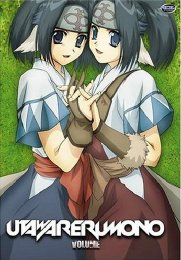
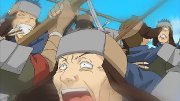
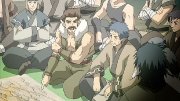




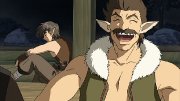

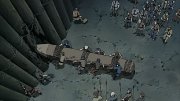
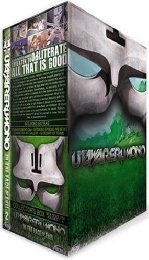
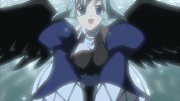

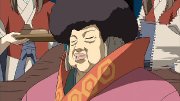
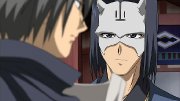


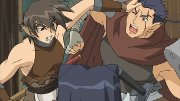
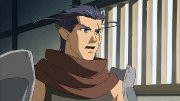
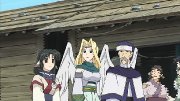
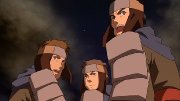

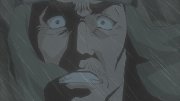

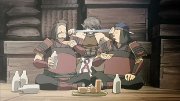

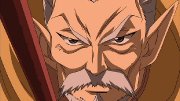

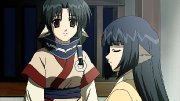










































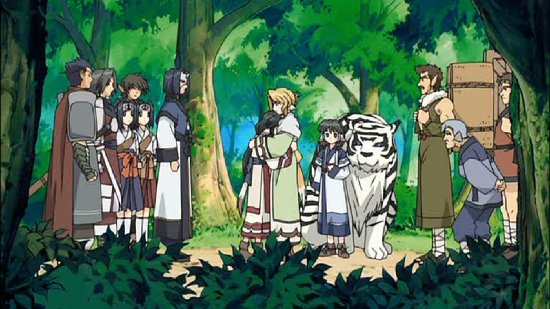




Your Opinions and Comments
Be the first to post a comment!